|
Building the Tom Henry RS
Pt 3:
Engine Assembly, Driveline Mods, Brake Upgrades and...Dyno
Testing.
|
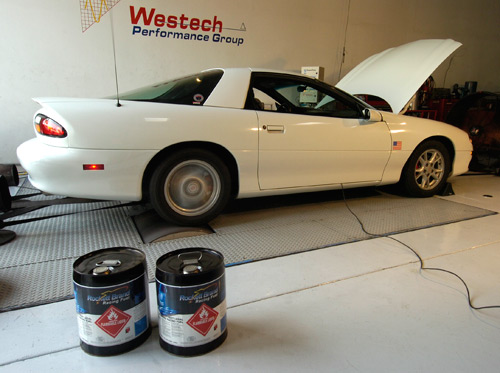 |
|
Image: CHpg Staff |
In the last part of the
THRS series, we had DeGroff's Cylinder Head Service
build us a pair of street high-performance, 3800 Series
II heads and we installed a Comp Cam and lifters.
In this part of the
story, we're going to finish off the engine. Next, we're
going to add some HD parts to the driveline appropriate
for our modified engine's torque output and do some
upgrades to the car's brakes. Finally, we'll go to the
chassis dyno to validate our work to date.
Heads On
|
 |
|
While the engine in the
Tom Henry RS is not supercharged, a
common use for MLS gaskets is boosted
engines. How much boost? With a stock
gasket, you're lucky to hold
half-a-dozen or so pounds boost whereas,
with a Cometic MLS gasket, it is not
uncommon for users to report 40 pounds
of boost without the use of o-rings.
Image: CHpg Staff. |
|
Combustion
chambers grow slightly in the valve unshrouding
and polishing processes and that decreases
compression ratio. To recover some of that, we
ordered Cometic head gaskets (PN H1773052S,
left, H1772052S, right). The Cometics are .052"
thick or about .011" thinner than stock and good
for about a tenth of a point more compression.
Hopefully, that will bring us back up to where
we were before we did the heads.
For the last
decade or so, Cometic Gasket, Inc. has promoted
multi-layered steel (MLS) head gaskets for
street high-performance and racing applications
of many engines, including the 3800. Initially,
the introduction of this type of gasket
generated mixed response. Some were disbelieving
that a set-up of stainless steel layers with
strange little bumps could seal their engine.
Today, the MLS design is widely accepted by
engine builders and being used in place of the
typical composite and/or copper designs. it is
also being use by O.E.'s in high-performance
applications, such as the 620-hp LS9 engine in
the Corvette ZR1. |
Multi-layered steel
offers benefits which cannot be attained with standard
head gaskets. The stainless in an MLS gasket withstands
temperatures in excess of 2000°F, about twice what a
standard gasket can take. Because they are the same
material throughout rather than most OE gasket's
steel-fire-ring-and-fiber composition; they don’t cause
as much bore distortion.
Some other benefits of
Cometic's design? Since it's not limited by the size of
the steel fire ring commonly found around the bores in
an OE gasket, a wide variety of custom bore sizes and
thicknesses are available. Need a thicker gasket to
modify your compression ratio or add piston-to-valve
clearance? Not a problem. Need to accommodate your
strange sized overbore? Chances Cometic can make what
you need with a short turn-around time.
|
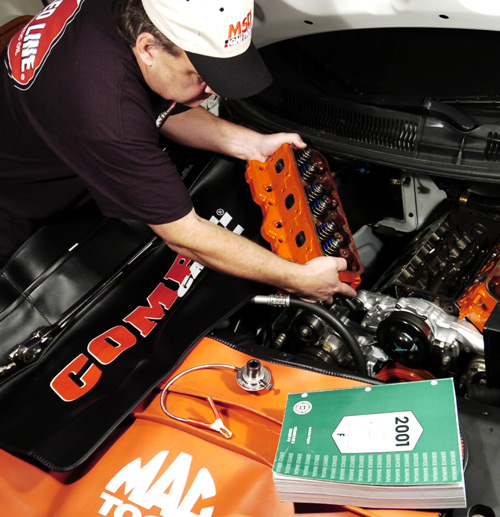 |
|
In spite of a 4th Gen
car's restricted underhood space,
getting the heads on-and-off a V6 is not
difficult because of the engine's small
size.
Image: CHpg Staff. |
We cleaned the bolt
threads in the block, scraped the decks, used a shop vac
to suck out any debris in the cylinders then wiped the
bores and the decks with MEK. We set the Cometic head
gaskets on the block decks then lowered the right head
onto the block. Next we installed the coil pack mounting
bracket to the left head because it's much easier to
tighten its bolts with the head off the engine. After
that, we dropped the left head on the block.
|
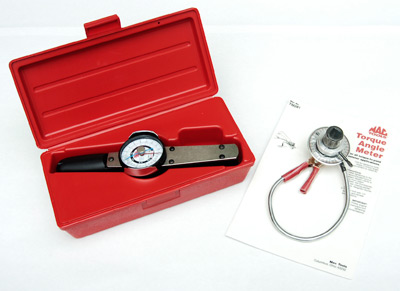 |
|
611.04) Important to the
reinstallation of the 3800's top end are
a torque angle meter and an inch-pound
torque wrench. A tool like the Mac Tools
Torque Angle meter (PN TM281N at right)
is required for tightening head bolts.
We used a Mac Tools inch-pound torque
wrench (PN TWDFX150N, at left) for
tightening upper and lower intake
manifold bolts.
Image: CHpg Staff. |
|
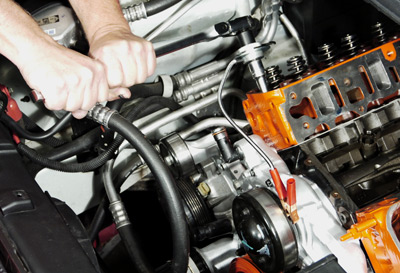 |
|
611.05) Many GM torque
specs list an initial figure, to which
you tighten using a torque wrench, and a
final torque angle number. The angle
meter goes between your ratchet and the
socket. The scale is fixed with the
clip. The pointer moves with the socket
and you read the angle on the scale. A
torque angle meter can be a little
difficult to use, mainly because of
awkward positions you get into trying to
apply torque without screwing-up the
measuring process. What we'd like is one
of the digital electronic torque angle
meters but, when we found out how much
they cost; we had to live with the
straight mechanical unit. Image: CHpg
Staff. |
The 3800's cursed,
torque-to-yield head bolts can only be used once, so we
installed a new set of Fel-Pro head bolts (PN ES74033).
A torque angle meter must be used for final head bolt
tightening. It's a difficult process, but stay calm–it
just takes time. Those of lesser strength may need to
squat on the front stabilizer bar, between the engine
and the radiator, to tighten some bolts. Use the
tightening pattern listed in the factory Service Manual.
|
The combination
of our Comp cam's smaller base circle and
thinner head gasket require a 7.000" pushrod.
Because we're going to buzz this motor to 6200
rpm, we ordered a dozen of Comp's Hi-Tech units
(PN 7936). Made from .080" wall-thickness,
seamless chromoly steel, they are 5/16" diameter
and a ton stiffer than O.E. pieces. We dabbed
Red Line Assembly Lube on each end then dropped
the pushrods in place.
Next we
reinstalled the stock rocker arm fulcrum bars
and the stock roller rocker arms. Rather than
GM's torque-to-yield rocker bolts, we installed
INTENSE-Racing reusable bolts (PN HSH-RAB) and
tightened them to 25 ft/lbs. We stuck new Fel-Pro
gaskets in the valve covers and put them on.
The upper and
lower intake manifolds weren't ready for
installation, so we put the engine reassembly on
hold and turned to some chassis and brake mods. |
|
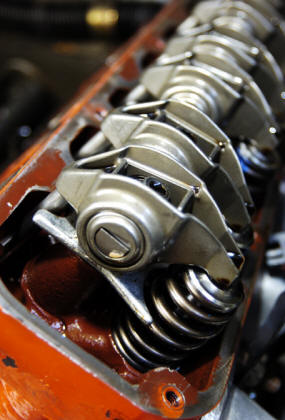 |
|
611.06) We decided to
break-in our modified V6 using the
stock, 1.6:1 roller rocker arms. Image:
CHpg Staff. |
|
|
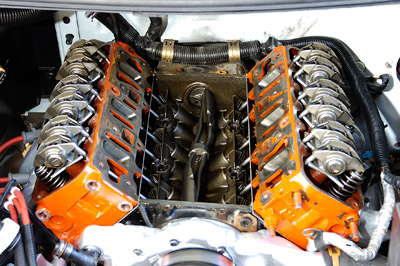 |
|
We're ready to install
the intake manifolds and the rest of the
upper engine dress. Some question our
decision to retain the engine's balance
shaft as that forces use of a single row
timing chain which is said by some to
not be durable with high tension
aftermarket valve springs. Nevertheless,
we chose to take the "risk" as the Roll
Master chain's supplier, INTENSE Racing,
insists it has adequate
reliability/durability for our
application and we'd rather not have the
engine shake at idle a no-balance-shaft
engine exhibits. Image: CHpg. |
Drivetrain Digest
Our eventual goal is
250-hp on the motor and, if we do nitrous, 300+.
Planning for that, we needed a clutch upgrade so we
called McLeod Industries' Billy Mieczkowski. He said
that the stock clutch, a 9-11/16-in. unit of 1200-1400
pounds pressure, was inadequate for our needs. We
drained the TREMEC T5 five-speed, removed it per the
factory Service Manual, then pulled the stock clutch
assembly and headed for McLeod.
Inspecting our parts,
Mieczkowski advised that, while the clutch disc had
plenty of material left, its damper springs and their
mounts in the hub were worn, a common problem with
six-cylinder discs. The stock stuff was scrap so we
replaced it with a McLeod clutch (PN 360131) and disc (PN
260275). The McLeod has significantly more pressure,
1875 lbs., and its disc, with an enhanced-organic facing
and HD hub and damper springs, offers better reliability
and durability at our higher torque output and engine
speed.
|
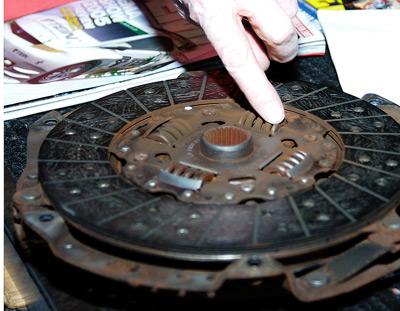 |
|
Here's the clutch disc we took
out of the Tom Henry RS. While there was plenty of
facing left, the seats for the damper springs were worn
which the McLeod people tell us is normal for V6 discs.
Image: CHpg Staff. |
|
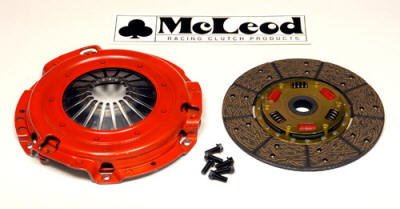 |
|
Replacing the O.E. clutch
hardware was this setup: a McLeod diaphragm clutch and a
McLeod organic-faced disc for street-high-performance
applications. Image: CHpg Staff. |
|
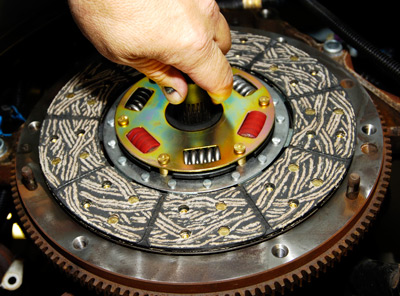 |
|
611.10) Before we put the disc in place,
we went over the flywheel's friction surface with a
Standard Abrasives Medium Surface Conditioning disc,
then wiped the surface with MEK. You'd be surprised how
often people attempt to put clutch discs in backwards.
This is how it should look, with the raised side of the
hub pointing to the back of the car. McLeod includes a
clutch pilot tool with every pressure plate. Image: CHpg
Staff. |
|
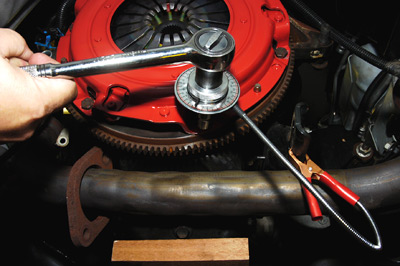 |
|
The clutch installation is
another of the many uses of our Mac Torque Angle Meter.
Image: CHpg Staff.
|
|
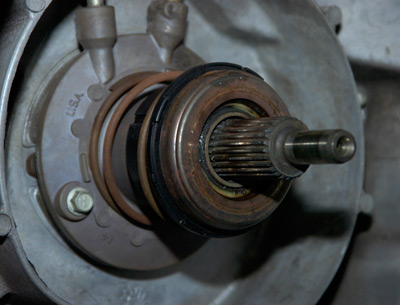 |
If your clutch release
assembly looks like this, replace it.
Image: CHpg Staff. |
The clutch release
bearing was worn. It's a GM-only part (PN 89060001) so
we ordered that and a pilot bushing (PN 24506531) from
Tom Henry Racing. We installed the new bearing on the
concentric clutch slave, changed the pilot, put the
trans back in then reinstalled the rest of the parts
removed to get the clutch out.
|
 |
|
Red Line MTL is a synthetic,
GL-4-rated gear oil blended especially for manual
transmissions which require a low-viscosity lubricant
and are used in racing or high-performance street duty
cycles. Image: Red Line Oil. |
|
We filled the T5 with
Red Line MTL, a low-viscosity, 70W80,
ester-based-synthetic, GL4, gear lubricant. MTL provides
excellent protection and improved shift feel in manual
transmissions which require low-viscosity lubricants. It
has the appropriate coefficient of friction for
cone-type synchronizers whereas some gear oils, engine
oils, and ATFs are too slippery for proper synchro
function. MTL's wide viscosity range facilitates proper
shifting over the full temperature range a transmission
may experience. Its synthetic base stocks have a high
viscosity index which insures constant viscosity as
temperature changes. MTL is a 70W at low temperatures
and a high 80, nearly an 85, at high temperatures. That
range provides adequate viscosity to prevent wear and
deaden gear noise. MTL has outstanding shear stability
and oxidation stability, so its physical characteristics
will change little with use. |
|
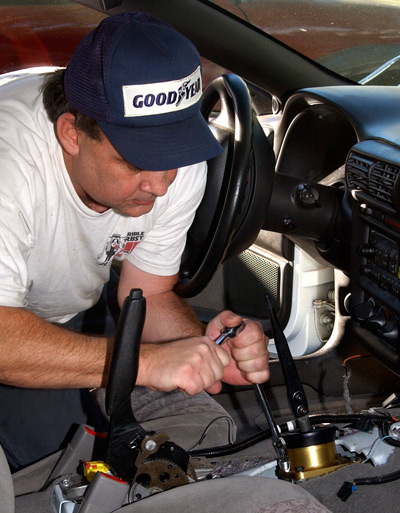 |
|
While it looks like you tear the
whole interior apart to install the Hurst Shifter, the
center console is easy to remove and the shifter is held
with only four bolts. You can do the job in an hour and
the reduction in shift throw and improvement in shift
feel is well worth the effort. Image: CHpg Staff. |
Working our way back,
we added a Hurst Billet/Plus Shifter (PN 391-5032) which
has a shorter throw and feels more precise because it
eliminates the stock shifter's rubber coupler. Hurst's
user-selectable “bias springs” provide the tension you
feel when moving the shifter, cross-car, in the neutral
gate. The default is all four springs. While drag racers
like hefty centering tension, street-drivers and road
racers might not. If that’s the case, remove the inner
springs. Finally, we added the Hurst shift lever for a
T56 six-speed (PN 2388572) which accepts the O.E. shift
knob, giving the interior a stock appearance.
|
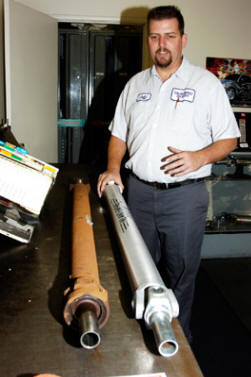 |
|
Inland Empire Driveline's
Manager, Jeff Gilroy, had our two driveshafts
side-by-side as he explained that, though less
high-speed vibration, less weight and better
acceleration, his company's product is a bolt-on,
win-win-win situation. Image: CHpg Staff.
|
|
The Tom Henry RS will
have a higher top speed because the engine is going to
have more top end and, after we installed Z-rated
Goodyear F1 GS-D3s in Part 1, we raised the speed
limiter to 118 mph and we may raise it again. This had
us wondering about the stock driveshaft. V6 shafts
become more prone to vibration at speeds beyond the
production speed limiter because of the interaction of
V6 firing impulses and the driveline's resonant
frequencies. To address this, GM sticks a fat vibration
damper on the driveshaft's front yoke. That's a cheap
solution but makes for a 20 lb. driveshaft and might not
be an effective fix, once top speed goes higher than
stock.
We had Inland Empire
Driveline Service build us a 41.5x3.0-in. driveshaft out
of .120 in. wall-thickness, 6061-T6 aluminum tubing and
forged 6061-T6 ends. Basically, this is an aftermarket
version of the unit used by Camaros with the 1LE option
but fitted with a V6 front yoke. Though it's larger, as
it's aluminum and lacks the big damper, there is a
whopping 50% weight reduction. At only 10 lbs, it has
far less rotating mass which not only eliminates
vibration at high speed but allows the car to accelerate
a little quicker.
|
|
 |
|
The big (and heavy) difference
between the stock, steel driveshaft and the
high-performance, Inland shaft is the stocker's damper.
Image: CHpg Staff. |
Better Stop
Stock brake pads on
later 4th Gen Camaros, the scary-expensive new units
from GM, are a great choice for hi-po street use, so we
kept them. If we start doing track days, we'll need a
more aggressive pad, but for now; stock is good.
Brake rotors are a
different story. They're a stunning example of how GM
cost cutting forces use of inferior materials. Stock
rotor durability, even for cars driven by people easy on
brakes, is lousy.
The problem is crappy,
low-silicon iron which lacks thermal stability causing
thickness variation to develop. Our O.E. rotors barely
made 40,000 miles before their thickness variation was
so great, the car shuddered upon every brake
application. The original pads had plenty of thickness
left, but the rotors were junk.
We pulled the caliper
assemblies, scrapped the GM rotors and replaced them
with Baer Brakes' EradiSpeed Plus parts (PN 2301006,
front, and PN 2302013, rear) which are more massive and
made of high-silicon iron. Additionally, the fronts are
a racing-derived, two-piece, reduced-weight design
consisting of an iron brake disc with a more efficient
cooling vent system bolted to an aluminum hat. For a
trendy look, EradiSpeed Pluses are drilled, slotted and
zinc-plated. These rotors eliminate brake shudder,
perform better, look cool and cost only about fifty
bucks more, per set, than O.E.
|
 |
|
Brake performance and
durability improve with the Baer rotors
which are a bolt-on enhancement.
Performance is better because of the
more efficient cooling vane design.
Durability improves because of the
better quality cast iron Baer uses.
Image: CHpg Staff. |
|
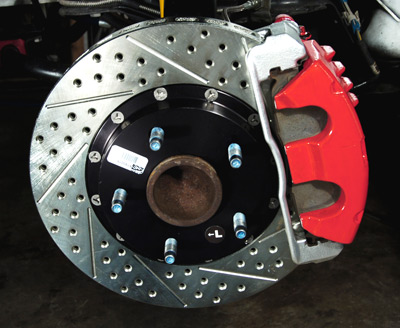 |
|
The Baer Eradispeeds are both
drilled, slotted and zinc-plated. The drilling and
slotting is mostly cosmetic as modern technology in
brake pads has made the "outgassing problem" an urban
legend. The zinc-plating prevents rust on non-swept
areas of the rotor. The appearance of Eastwood's red,
caliper paint can't be beat. Image: CHpg Staff. |
Now that the THRS has
good-looking, drilled and slotted rotors, we needed to
tart-up the brake caliper assemblies a bit. Using
Standard Abrasives BriteRite Pads, we scrubbed them with
Simple Green and hot water then dried them with shop
air. Using Eastwood High Temp Coating (PN 10396Z), we
painted the mounting brackets silver and, using Brake
Caliper Coating (PN 12070Z), we painted the calipers
red.
|
Caliper painting takes
planning. Eastwood's polyurethane paint lasts about four
hours, once its reactant is added. In that four hours,
give all calipers two coats with at least an hour
between coats.
By the time we got
around to revising this part of the project for the
Internet version of the series, the brake caliper finish
was nearly two years old. Eastwood's product has proven
quite durable. When we wash or blow-off the brake dust,
those DIY-painted calipers still look great. |
|
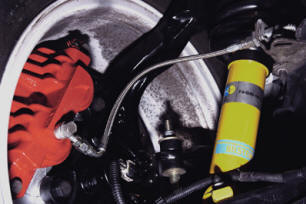 |
|
On the back side of the brakes
was more performance hardware: our Aeroquip,
braided-stainless-steel covered Teflon brake hoses.
Their main advantage is an improvement in pedal feel due
the elimination of the slight expansion stock hoses
sustain during heavy brake applications. Image: CHpg
Staff. |
|
Our final brake upgrade
was braided-stainless-steel-covered, Teflon brake hose
assemblies. Building them with components from Eaton's
Aeroquip division, in front, we used 10". Aeroquip hoses
(PN FBPA0390-10) and, in the rear, between the calipers
and the ends of the hard lines on the rear axle, 8"
hoses (PN FBPA0390-8). Each has a straight, AN-3 fitting
on one end and a 90° on the other. To connect to the
calipers, we used long, 10-mm. banjo fittings (PN
FCM2947) in front and short 3/8" banjos (PN FCM2949) at
the rear, the O.E. banjo bolts and new copper washers.
To connect to the hard lines on the frame in front and
at the ends of the rear axle, we used Aeroquip AN-3 to
3/8-24 inverted-flare adapters (PN FCM2936). Aeroquip
doesn't make parts to connect the chassis' hard line to
the junction on the axle, so we had an 11" hose made by
Orme Brothers, a hose and fitting retailer in
Northridge, California. It has a 7/16-24 inverted flare
connection on one end and a T, which bolts to the axle
and accepts two 3/8-24 inverted flare fittings, on the
other.
GM used a mix of metric
and fractional inverted flared fittings on some 4th Gen.
Camaros. If you make braided brake hoses for these cars,
measure the fittings, first, before ordering parts.
Aeroquip makes a nifty "Port and Thread Identification
Kit" (PN FCM3644) for this purpose.
Motor Ready
"Extrude Hone" is the
brand name for "abrasive flow machining" (AFM). Invented
50 years ago, during the Nike antiaircraft missile
program, it's widely used in the aerospace and
industrial fields. In the early '70s Southern
California's Melendez family formed Extrude Hone AFM,
Inc. and introduced the process to the automotive
industry. By the 1980s, its use became popular with
high-performance-street and racing engine builders.
Today, it's even used by OE's for limited production,
high-performance applications.
|
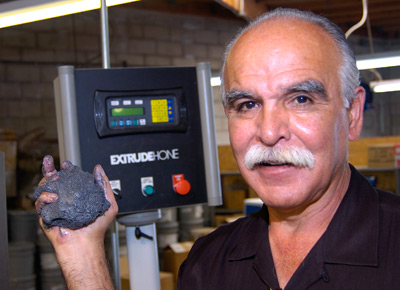 |
|
Ed Melendez, President of Extrude
Hone AFM, shows us a ball of the abrasive polymer used
to Extrude Hone the THRS's intake and exhaust manifolds.
Ed has the singular satisfaction being one of the
World's largest consumers of Silly Putty.
Image: CHpg
Staff.
|
This process removes
material from the interiors of intake manifolds and
other parts, leaving a smooth, polished surface behind.
AFM's active ingredient is silicon carbide particles
carried in a creamy polymer. The polymer is actually
Silly Putty and the Extrude Hone Corporation is the
world's largest manufacturer of the stuff and Extrude
Hone AFM is one of its biggest customers.
The abrasive polymer is
forced, or "extruded" through the part abrading and
polishing all surfaces exposed to it. The amount of
material removed depends on how long the part is
processed, the particle size and where in relation to
the point of polymer injection the abrading is taking
place. This modest enlarging and polishing improves flow
through the part.
|
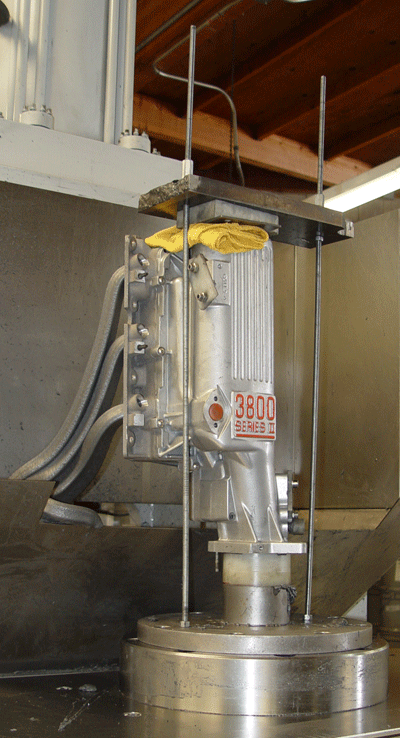 |
|
The part to be honed is bolted to
a big nozzle assembly through which the Silly
Putty/silicone carbide mix is forced through the part.
Image: Willie Melendez. |
|
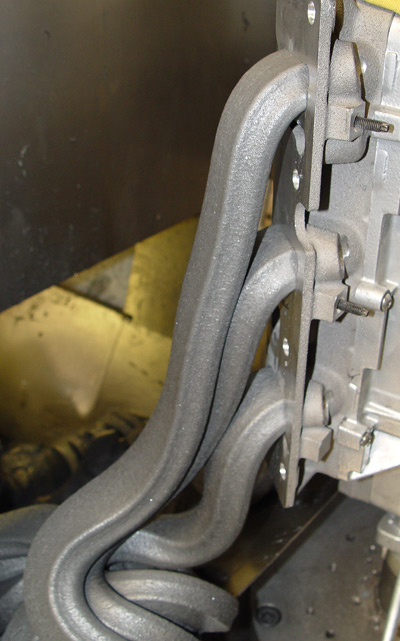 |
|
The silicone carbide removes
material from the inside of the manifold. Imagine this
as porting all interior surfaces of the manifold with
the amount of material removed being greater towards the
throttle body and lesser towards the port exits. Image:
Willie Melendez.
|
Typically, if you've
fitted your 3800 with a set of ported heads, the lower
intake manifold is "port-matched" using abrasive tools
and traditional porting techniques. Additionally, with
an induction system like that used on the 3800 Series
II, there is a performance gain in porting and polishing
the intake plenum, however, effectively doing that can
be challenging because of the difficulty in reaching
areas deep inside it.
Extrude Hone AFM
eliminates these troubles while doing a more uniform job
of removing material. it rounds all sharp edges and
polishes all surfaces. The process is done to the upper
and lower intake manifolds while they are assembled so
port matching of the two parts, as might be required
during the traditional porting process, is unnecessary.
|
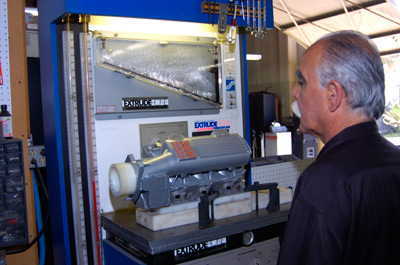 |
|
After Extrude Honing, Ed
Melendez, himself, flow tested our upper intake
manifold. Image: Willie Melendez. |
The day we visited
Extrude Hone AFM to pick-up our intake and exhaust
manifolds, we requested a flow test and observed while
they did it. Tested on Extrude Hone's Super Flow SF600
Flowbench, air flow through the intake manifolds
increased by a whopping 25% and exhaust flow increased
an average of 13%.
You're asking, "What's
up with cast iron manifolds?" We'll switch to headers in
Part 4 of this series. For now, we want to try Extrude
Honed and coated stock manifolds to see if they can be a
budget-minded alternative to headers.
|
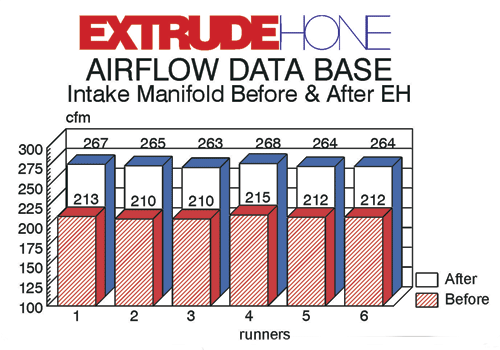 |
|
This is the data from the intake
flow test.
Image: Extrude Hone AFM.
|
|
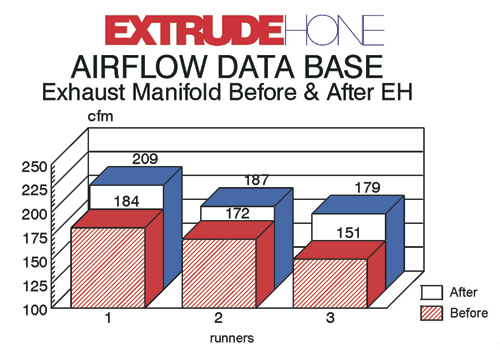 |
This is the data from the exhaust
manifold flow test.
Image: Extrude Hone AFM. |
We installed the lower
intake manifold using a stock GM intake gasket set (PN
89017819) which we prefer because of the gaskets' metal
cores. During the lower intake manifold installation,
follow the Service Manual's instructions for tightening
the bolts and use of a thread locking compound is
required.
|
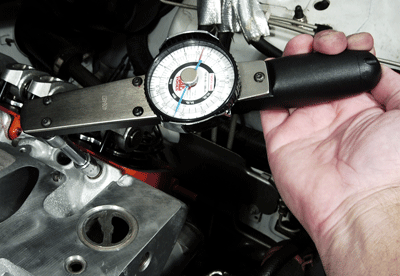 |
|
Proper tightness of the lower
intake manifold bolts is critical. Additionally, since
these bolts are tightened to a somewhat low torque, a
thread locker is required. Use of an inch-pound torque
wrench is advised. Image: CHpg Staff. |
Because the ports in
the two intake parts have been enlarged, the gasket
between them must be trimmed to enlarge its port
openings. We laid a Fel-Pro upper intake manifold gasket
(PN 95746) on a piece of plywood then used an Xacto
knife to enlarge its port openings by trimming the fiber
material right up to the RTV silicon sealing bead.
|
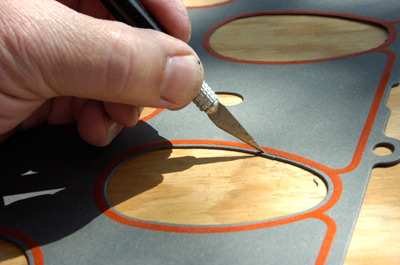 |
|
This is one of the time-consuming
tasks if your 3800 has an Extrude Honed or ported upper
and lower intake manifold. A sharp Xacto, a steady hand
and a slab of plywood are keys to good gasket
modification. Image: CHpg Staff. |
We had the upper intake
manifold powder-coated silver by Extreme Performance
Heat Coatings then installed it on the engine. Many of
the upper intake manifold fasteners are smaller than you
might expect. Tightening them requires an inch-pound
torque wrench. Observe service manual torque specs and
its tightening pattern.
|
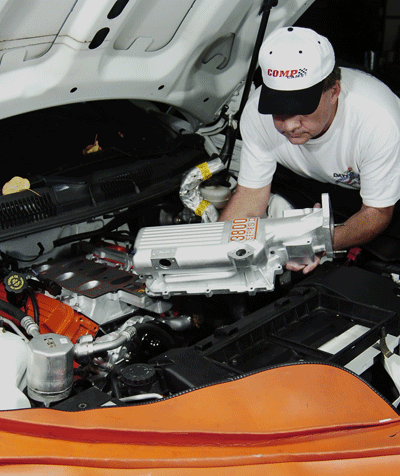 |
|
Our Extrude Honed and Extreme
coated intake manifold goes on. Tightening the upper
manifold bolts is another critical process. To avoid
stripping threads or breaking bolts, use a torque
wrench. Image: CHpg Staff. |
Extreme Performance
Heat Coatings applied a silver metallic-ceramic coating
to the outside of the exhaust manifolds and a thermal
barrier coating to the inside. Extreme uses raw
materials from Techline Coatings, one of the top
suppliers in the performance coating business. As a
result, the manifolds look better, radiate less heat and
can be used without their stock heat shielding.
|
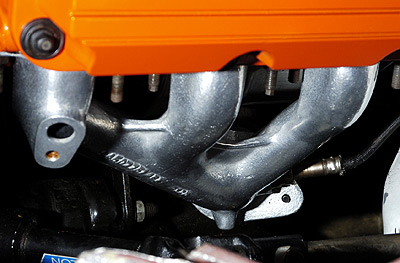 |
|
The Extrude Honed and Extreme
coated exhaust manifolds can be a low-cost alternative
to headers. One nice thing about them is they offer a
performance increase but, also, bolt up to the stock
downpipe assembly. Image: CHpg Staff.
|
Next, a final
beautification project: we painted the crankshaft
balancer, brackets, housings and some pulleys on the
front of the engine, the lower intake manifold and the
valve covers. For this we used Eastwood Co. products,
Extreme Chassis Black (PN 11175Z), Chevrolet Orange (PN
10016Z) and Stainless Steel High-Temperature Coating (PN
10364Z).
It Runs!
|
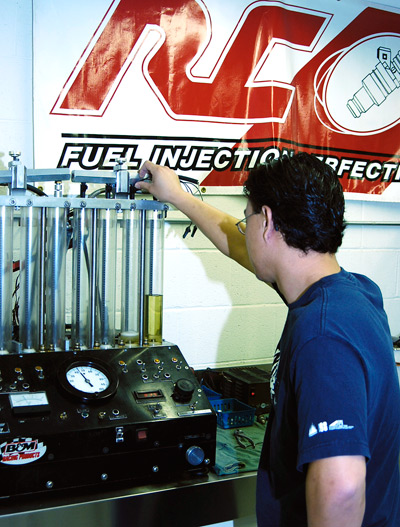 |
|
611.30) The first two steps in the
injector testing process at RC Engineering are 1)
ultrasonic cleaning (not shown) and flow testing, which
RC Engineering's John Park is doing here. Image: CHpg
Staff. |
We sent our fuel
injectors to RC Engineering cleaning and testing. In
tuning our mod'ed V6, we'll start with 19 lb/hr., stock
injectors but, if it needs more fuel than they can
provide; we'll step-up to RC's 21.5 lb/hr. units. After
RC's test, we stuck the injectors back in the fuel rail
and reinstalled it.
|
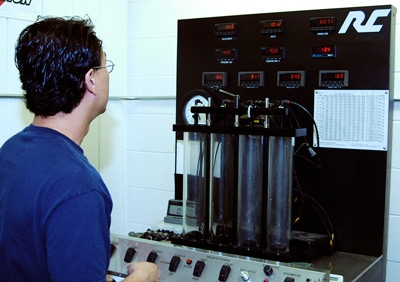 |
|
The third step is testing the
injector on a different test bench to analyze the
injector's flow pattern. Image: CHpg Staff.
|
We got the ignition
system up on the bench to install MSD Blaster Two-Tower
Coil Packs (PN 8224) for the GM "waste-spark",
distributorless ignition systems used on 3800s. The MSDs
put out up to 40kV which, when they're used in an
inductive ignition application like the THRS V6, is only
slightly more than the OE coils. Where the Blasters are
an advantage is during high-load operation at engine
speeds beyond where the stock coils normally operate.
Our project's engine is soon to get a rev limit higher
than stock and future mods, such as nitrous oxide
injection, will put a higher load on the ignition.
Better materials, such as higher-quality copper wire,
and more robust construction means the MSDs will be more
reliable when the combination of higher rpm and higher
ignition loads typical of a modified engine are present.
These coils, along with MSD Super Conductor plug wires
installed previously, give us a performance margin we
like.
|
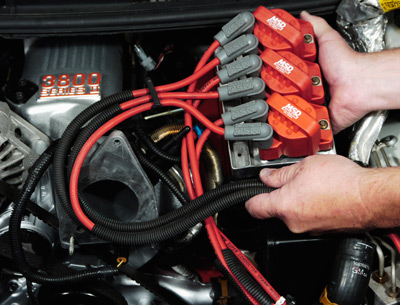 |
|
Our ignition mods are: a set of
MSD coils, which are capable of higher spark output, and
a set of MSD Superconductor plug wires. Image: CHpg
Staff. |
|
 |
|
Image: MSD Ignition ( Click Image for
Larger View )
|
|
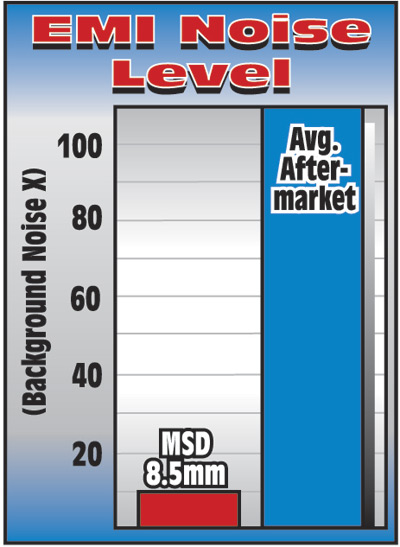 |
|
Superconductor 8.5-mm spark plug
wire was originally devised for use on racing engines in
cars with 2-way radios. It has a low resistance per unit
length--typically 50 ohms per foot--but a high level of
ignition noise suppression.
Image: MSD Ignition. |
We installed a fresh
set of Denso Iridium Power IT20 spark plugs. We've used
the IT-20 since the beginning of the Camaro
Performers magazine version of this project in 2005
and always have had good results. It is a heat range
colder than stock and its iridium tip is more durable
but has less resistance than platinum. Its small, 0.4-mm
center electrode and tapered ground electrode give the
spark maximum exposure to the incoming, air-fuel charge.
In short, we think the IT-20 is the best spark plug
choice for 3800s in street high-performance and mild
racing applications.
|
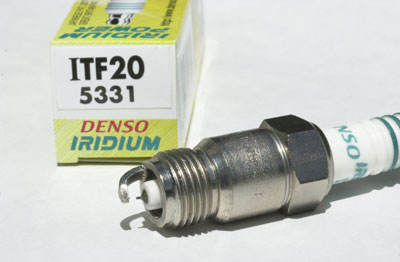 |
|
611.38) A Denso Iridium Power IT20 as
used in the Tom Henry RS engine. The main attraction of
the Denso is low resistance, from the use of Iridium in
the center electrode, high suppression and the cut-back,
V-shaped side electrode. Image: CHpg Staff. |
Oxygen sensors are
critical to drivability. We replaced the Camaro's, O.E.
sensors with Densos (PN 234-418, front, 234-4087, rear).
The Denso "O2S" is better because its aluminum-oxide
"trap layer" covers the sensor element and resists
damage to its platinum electrode and a porous, PTFE
(Teflon) filter on the sensor's atmospheric side
prevents moisture or contaminants from degrading
accuracy.
|
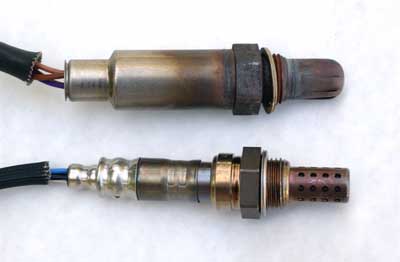 |
|
The stock Delphi oxygen sensor
used in 2001 V6 Camaro and, below, the better choice--a
Denso O2S. Image: CHpg Staff. |
|
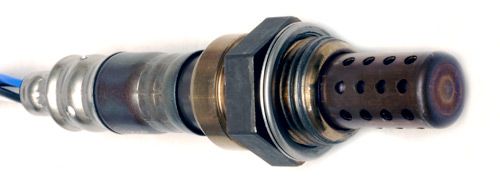 |
|
This is a four-wire Denso
oxygen sensor for a '97-'02 3800 (PN 234-4018). We use a Denso
on any O2S replacement as we think it's better than the
Bosch or Delphi units. Today, Denso O2Ses are stock on
some but not all GM vehicles. Image: CHpg Staff. |
|
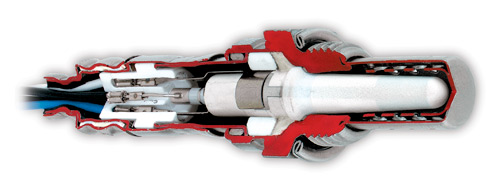 |
|
The same sensor cut open and painted-up
all nice. Its active component is the white, spear-like
element which is made of zirconia and has a
thin layer of platinum inside and outside. The inside is
open to the atmosphere and the outside is exposed to
exhaust flow. The difference between atmospheric oxygen
content (constant 21%) and exhaust oxygen content
(varies from zero to about 2%) generates a voltage which
varies from 100 to 950 millivolts. Image: Denso Sales
of California, Inc.
|
Finally, we reconnected
the exhaust, coolant plumbing and wiring. To reduce the
air bubble in the cooling system until the thermostat
opens, with the 'stat out and the water outlet off, we
filled the engine with a gallon of Dexcool antifreeze, a
bottle of Red Line Water Wetter and distilled water. We
reinstalled our Stant, 180° 'stat. A 160 was tempting,
but running that cool sets code P0182 for excessive
coolant warm-up time. Custom reprogramming can fix that
and we'll do that later, then try the 160.
We double-checked
everything, then lit the motor. For a few seconds,
lifters clattered, then the engine settled to a somewhat
less-noisy, but unstable idle. We connected our Bosch
Mastertech scan tester to read engine data. While idle
speed fluctuated, the engine was not stalling, no codes
set nor were idle air control (IAC) counts or fuel trims
way out of line. We used Mastertech's IAC function to
temporarily raise idle to 1000 rpm and the engine
smoothed-out. Once the thermostat opened, we opened the
cooling system bleeder until we saw coolant, then
topped-off and capped the radiator. We shut the engine
off and checked for leaks.
A drive around the
neighborhood showed that, while we lacked idle stability
below 1000 rpm, at light-to-medium load, the car ran ok
to our temporary, 4000 rpm rev limit. On a longer,
weekend test drive, not only did we have a funky idle
but we also observed knock retard ("KR"). We weren't
sure if this was "false" knock retard, due to valve
train noise, or real detonation, resulting from a
whacked-out fuel map too lean for our camshaft/cylinder
head package.
After changing the oil
filter, we did another 300 miles of easy driving to 1)
break-in the new parts and 2) do additional Mastertech
data logging to learn more about KR.
Cal Challenges
In Part 1, we used a
Hypertech Power Programmer for minor changes in the
engine computer calibration, however, the more
aggressive Comp Cam, bigger Manley Valves, better
flowing DeGroff heads and Extrude Honed manifolds we've
added pose a challenge the Hypertech was never designed
to address. No way could we continue to use it.
While there are a
number of aftermarket tuners having experience with 3800
Series II calibrations for racing and
non-emissions-legal, street applications, the
aftermarket has done little with "cals" for seriously-mod'ed,
street-legal V6es, so we knew a calibration which
exhibited good drivability, exhaust emissions compliance
in California and other states with stringent emissions
tests as well as a performance increase would be a
challenge.
|
 |
|
Z-Industries' Ron Zimmer (right)
and a Camaro Homepage staff member discuss the initial
reprogramming of the THRS engine controller. Image: CHpg
Staff. |
We retained,
Z-Industries of Temecula, California, a top aftermarket
cal specialist. Z-I's owner, Ron Zimmer, told us that
the computer for the later V6s has programming as
complex as that of GM's latest stuff for the C6 Vette.
The cal for our project was a arduous task, even for a
pro like Zimmer.
On our first visit,
Z-Industries made progress on idle quality, worked on
knock retard strategy, revised wide-open throttle fuel
and spark function, changed the fans-on temp to 185°F
and reset the rev limiter to 6200 rpm. This took several
reflashes of THRS's ECM followed by road tests with
Zimmer riding shotgun, watching ECM data on his Bosch
TECH2 scan tester.
|
 |
|
Z-Industries uses a Bosch
Diagnostics TECH2 scan tester to transfer the modified
computer program to the car's ECM. Image: CHpg Staff. |
While putting more fuel
to the engine had us using our mods to near their full
potential; we still had knock retard. Our Mastertech now
showed some "KR" under load, typical of detonation
rather than "false knock". We added five gallons of
Rockett Brand 100-oct. unleaded racing gasoline, road
tested and saw less knock retard, but it still wasn't
eliminated.
Since Part 1, Green
Filter revised its Camaro air filter (PN 2021) with
"custom fit tabs" on its edges. "Going Green" is a good
thing, so we dropped an updated filter in the air box
base. We added a Whisper Motorsports, carbon fiber air
box lid (PN CFLid-6-99/02) which eliminates the baffles
and fins inside the stock lid. The Whisper Lid replaces
the silly, plastic intake resonator, attaches the stock
rear air duct and relocates the intake air temperature (IAT)
sensor. By using carbon fiber in this Lid, Whisper
Motorsports stiffens the assembly, reduces it weight and
vastly improves the appearance of the underhood. Plus,
the Whisper Motorsports air box works well on a modified
V6.
|
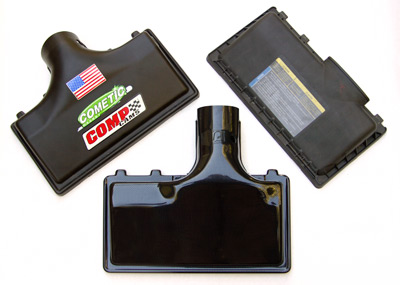 |
|
The three air box lids we tested.
Top right is the stocker. Top left is an SLP V8 air box
lid which works with a V6 if the air ducts are
substantially modified. A problem with our SLP lid is it
tended to warp. Once it does, it leaks air. The best
choice in V6 air box lids is the Whisper Motorsports
unit (bottom) CHpg Staff.
|
|
 |
|
The Whisper lid accepts a stock-sized air
filter element, either an O.E. filter or
our Green Filter and it clamps to the stock air box
assembly. It, also, accepts the stock rear air duct and
the stock IAT sensor. Image: CHpg Staff. |
Back at Z-Industries, a
week later, we had Zimmer back-off the spark a scosche
and add a bit more fuel. He, also, spent several hours
tweaking idle programming. When we left his shop, idle
stability was improved and the best we could expect
considering our cam profile. We decided we were,
finally, ready for Westech's Super Flow SF840 chassis
dyno.
What Kind of Power Does
it Make?
|
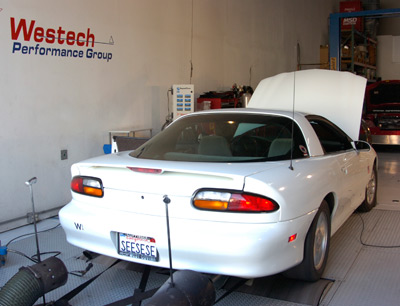 |
|
Finally...the Tom Henry RS back
on Westech's Superflow WynDyn chassis dyno.
|
|
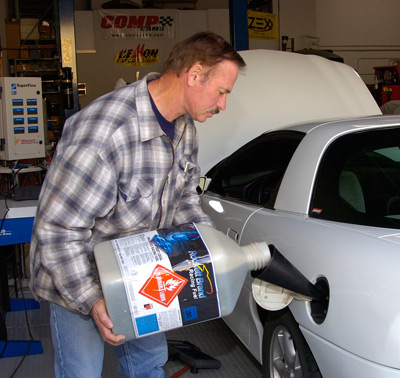 |
|
Rockett Racing Fuel's Tim Wusz
adds some of his fine 100-octane unleaded Racing
Gasoline to the project car. Typically, we bump the
octane to 95.5-96 for chassis dyno testing where we are
adjusting spark calibration. Image: CHpg Staff. |
Several days later,
Rockett Brand Racing Fuel's, Tim Wusz, Ron Zimmer and we
reconvened at Westech. Dyno Technician, Ernie Mena
strapped our car to the Super Flow and made two baseline
passes. Darn knock retard was present under load, so Tim
Wusz supplied some more of his fine 100-oct. unleaded
for us to mix with the 91-oct. pump gas already in the
tank, then Ernie made several more passes during which
Ron Zimmer tweaked the fuel and spark tables. This put
our air-fuel ratio at WOT at an ideal 12.8:1 and further
improved idle stability, however, we still had a slight
KR issue. Nevertheless, we signaled Ernie that we were
done fooling with the cal (for now) and to go for the
money shot.
|
 |
|
Ron Zimmer at work on our
calibration. Image: CHpg Staff. |
Bottom line: we're
making progress with the Tom Henry RS. Eight passes at
Westech averaged, at the wheels, 206.0 horsepower
(SAE-corrected) at 5350 rpm and 218.0 pound/feet torque
at 4600 rpm. That equates to about 250 hp SAE net at the
flywheel or around a 25% improvement over stock. Since
we are already at the 250-hp goal set back in Part 1 and
we've got plenty of tuning to do and a few more
modifications, we're raising our power goal to 270-hp.
Now that's what we're talkin' about!
|
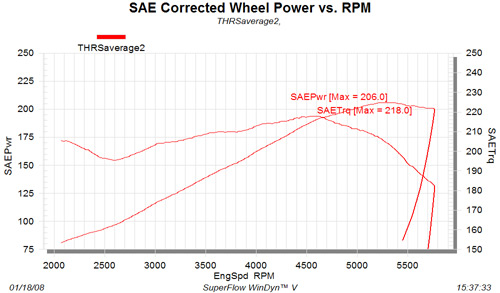 |
|
While, right now, we're happy
with 206-hp at the wheels, if you look at the early part
of the torque curve, clearly, there's work to be done.
The engine is weak in the low-mid-range, actually
loosing torque between 2000 and 3500 rpm. Also, the
curve is a bit jagged, evidence of knock retard. Lastly,
we've yet to test the engine past about 5700 rpm. That's
all coming later in the series. Image: CHpg Staff. (
Click Image for Larger View )
|
When the THRS comes
back in Part Four of this series, hopefully, we'll have
the knock retard issue solved, turn-in some good
performances on straight pump gas and add some more
modifications.
Yella Terra Rocks
The first version of
this series, in Camaro Performers magazine back
in 2006, reused the SLP 1.8:1 rocker arms from Part One.
During preparation of the last part of the magazine
series, we found the SLP rockers were not compatible
with our Comp camshaft. The result was valve float above
5800 rpm and that was in-spite of SLP's Chief Engineer
at the time insisting the 1.8 rockers would work with
our cam.
|
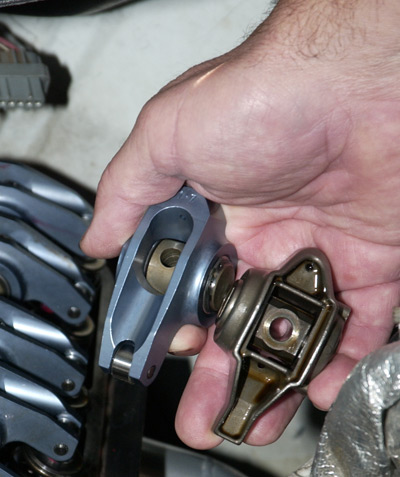 |
|
At left is a Yella Terra roller
rocker arm for a 3800 Series II or, as they call it in
Australia, the "Ecotec V6". This particular unit is a
1.7:1. Note that it's smaller and lighter than the
3800's stock, investment cast steel, roller rockers.
Image: CHpg Staff. |
The solution was two
fold. First, as told in the last part of this series, we
replaced the Comp Cams valves springs we used at first
with springs (PN PSI-LS1511) having slightly more open
pressure which we sourced from Katech, Inc., the
Michigan firm which runs the engine program for GM
Racing's C6.R road race Corvettes.
Secondly, we installed
a different 1.8:1 rocker arm design which was lighter.
With a little investigation, we learned the manufacturer
of the SLP rocker was an Australian company called
"Yella Terra". Via email, we contacted Mark Conner,
Yella Terra's Technical Sales Manager, and explained our
problem to him. Conner responded quickly explaining that
the 1.8 SLP rocker was the company's first aftermarket
rocker design for the 3800. He, also, confirmed that it
had been intended for stock cams and was not compatible
with aggressive aftermarket profiles at higher rpm.
Conner went on to say
that Yella Terra had designed the SLP rocker several
years ago but had since discontinued that part. The SLP
1.8s were 16% lighter, per rocker, than the O.E., 1.6:1
stockers. Yella Terra has since further developed its
3800 Series II rockers by such that it was an additional
8% lighter yet had the same level of strength as the
first design. The new Yella Terra rocker is called
"Ultralite" and not only is its overall weight less, its
reciprocating mass is reduced even more by revising the
part's structure, especially at the valve end of the
arm. Mark Conner agreed to ship us two sets of the
Yella Terra second design rockers, 1.7s and 1.8s.
Because the Yella Terras have higher pushrod seats we
had to change pushrods so we ordered a set of 7.350"
Hi-Tech pushrods (PN 7950) from Comp.
|
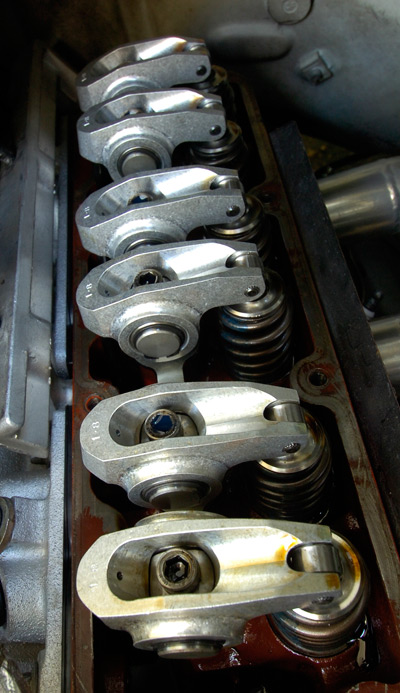 |
|
We tested the Yella Terra 1.7s
for while and found they work ok with our Comp Cam and
the first set of valve springs we used, but we wanted
the slight power increase which comes from a 1.8:1
rocker. These are the Yella Terra 1.8 rockers we'll use
on the project car for the long-term along with Katech
valve springs. Image: CHpg Staff. |
Several weeks later,
when the Aussie rockers arrived, we put their support
bars on the heads, dropped in the longer Comp pushrods,
lubed the pushrod and valve stem tips with Red Line
Assembly lube, oiled each rocker with Red Line 10W30
then installed all those parts. We retorqued the rocker
bolts, then replaced the valve covers and other parts
removed to change the rockers.
In Part Four of the Tom
Henry RS project, we'll add headers, do some additional
tuning then run on the chassis dyno, again.
Baer Inc.
Suite 1201
3108 W. Thomas Road
Phoenix, Arizona 85017
602 233 1411
www.baer.com |
Bosch Diagnostics
2030 Alameda Padre
Serra
Santa Barbara CA 93103
800.321.4889
www.boschdiagnostics.net |
Cometic Gasket
8090 Auburn Road
Concord OH 44077
800.752.9850
www.cometic.com |
Comp Cams
3406 Democrat Road
Memphis, TN 38118
901.795.2400
www.compcams.com |
DeGroff's Cylinder Head
Service
18736 Parthenia #2
Northridge CA 91324
818.701.5274 |
Denso Sales of
California
3900 Via Oro Av.
Long Beach CA 90810
310.513.8582
www.densoaftermarket.com |
Eastwood Company
263 Shoemaker Rd.
Pottstown PA 19464
800.345.1178
www.eastwoodco.com |
Eaton Corporation
(Aeroquip)
1660 Indian Wood Circle
Maumee, Ohio 43537
419-887-9664
www.aeroquip.com/pages/performance.html |
Extreme Performance
Heat Coatings
515 N. Elevar St.
Oxnard CA 93010
805.485.2667
www.xtremeperformanceheatcoatings.com |
|
Extrude Hone AFM
8800 Somerset Bl.
Paramount CA 90723
562.531.2976 |
Federal Mogul
Corporation (Fel-Pro)
26555 Northwestern Highway
Southfield, Michigan 48034
248-354-7700
www.federal-mogul.com/aftermarket |
Goodyear Tire and
Rubber Co.
see your local Goodyear
dealer
www.goodyear.com |
Green Filter
Box 149
Mt. Braddock PA 15465
724.430.2050
www.greenfilterusa.com |
Hurst Shifters
9142 Independence Av
Chatsworth CA 91311
818.882.6422
www.hurst-shifters.com |
Inland Empire Driveline
Service
4035 E. Guasti Rd.
Ontario CA 91761
800.800.0109
www.iedls.com |
INTENSE Racing
8430 Estates Court
Plain City OH
43064-8015
614.207.2420
www.intense-racing.com |
Katech, Inc.
24324 Sorrentino Ct.
Clinton Twp MI 48035
586.791.4120
www.katechengines.com |
McLeod Industries
1600 Sierra Madre
Circle
Placentia, CA 92870
714-630-2764
www.mcleodind.com |
|
Orme Brothers
18453 Parthenia Pl.
Northridge CA 91325
818.885.1414
www.ormebrothers.com |
RC Engineering
20807 Higgins Court
Torrance CA 90501
310.320.2277
www.rceng.com |
Red Line Synthetic Oil
Corporation
6100 Egret Court
Benicia CA 94510
800.624.7958
www.redlineoil.com |
Rockett Brand Racing
Fuel
3703 W. Lake Avenue,
Suite 75
Glenview IL 60026
800.345.0076
www.rockettbrand.com |
Rockauto
rockauto.com |
Tom Henry Racing
Box 68
Bakerstown PA 15007
877.842.4389
www.tomhenryracing.com |
|
Whisper Motorsports
Suite 305
4400 118th Av. North
Clearwater FL 33762
727.573.1292
www.whispermotorsports.com |
Yella Terra USA
1935 Tommy Webb Drive
Meridian MS 39307
601 485-3355
www.yellaterra.com.au |
Z-Industries
31200 Santiago Rd.
Temecula CA 92592
951.303.6857
www.z-industries.com |
|